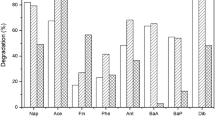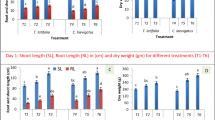Abstract
The development of the bioaugmentation during the phytoremediation of contaminated water with diesel in pilot horizontal subsurface flow constructed wetlands was investigated for 63 days. The objective of this study was to examine the enrichment of rhizobacteria in a pilot-scale system for efficient treatment of total petroleum hydrocarbon (TPH) effluent. A consortium of three rhizobacteria strains (Bacillus aquimaris, Bacillus anthracis and Bacillus cereus), which were able to utilize hydrocarbon compounds as sole carbon sources, was injected into the constructed wetlands (batchwise operation) planted with Scirpus grossus. The TPH removals from water, without or with the addition of rhizobacteria, were found to be 72 and 84%, while from sand was found to be 59 and 77%, for each treatment, respectively. These results showed that the rhizobacteria strains could enhance S. grossus growth by decreasing diesel stress and protecting S. grossus against diesel, with 12 and 18% additional TPH removal from water and sand, respectively. Our results demonstrate that S. grossus is potential to improve the phytoremediation of hydrocarbon contaminants through inoculation with effective rhizobacterial strains.





Similar content being viewed by others
References
Agamuthua P, Abioye OP, Abdul Aziz A (2010) Phytoremediation of soil contaminated with used lubricating oil using Jatropha curcas. J Hazard Mater 179:891–894
Ahmad F, Iqbal S, Anwar S, Afzal M, Islam E, Mustafa T, Khan QM (2012) Enhanced remediation of chlorpyrifos from soil using ryegrass (Lollium multiflorum) and chlorpyrifos-degrading bacterium Bacillus pumilus C2A1. J Hazard Mater 237–238:110–115
Al-Baldawi IA, Sheikh Abdullah SR, Suja’ F, Anuar N, Idris M (2013a) Phytotoxicity test of Scirpus grossus on diesel-contaminated water using a subsurface flow system. Ecol Eng 54:49–56
Al-Baldawi IA, Sheikh Abdullah SR, Anuar N, Suja F, Idris M (2013b) A phytotoxicity test of bulrush (Scirpus grossus) grown with diesel contamination in a free-flow reed bed system. J Hazard Mater 252–253:64–69
Al-Baldawi IA, Sheikh Abdullah SR, Abu Hasan H, Suja’ F, Anuar N, Idris M (2014) Optimized conditions for phytoremediation of diesel by Scirpus grossus in horizontal subsurface flow constructed wetlands (HSFCWs) using response surface methodology. J Environ Manag 140:152–159
Babatunde AO, Zhao YQ, O’Neill M, O’Sullivan B (2008) Constructed wetlands for environmental pollution control: a review of developments, research and practice in Ireland. Environ Int 34:116–126
Bao M, Wang L, Sun P, Cao L, Zou J, Li Y (2012) Biodegradation of crude oil using an efficient microbial consortium in a simulated marine environment. Mar Pollut Bull 64:1177–1185
Barac T, Taghavi S, Borremans B, Provoost A, Oeyen L, Colpaert JV, Vangronsveld J, van der Lelie D (2004) Engineered endophytic bacteria improve phytoremediation of water-soluble, volatile, organic pollutants. Nat Biotechnol 22:583–588
Bento FM, Camargo FAO, Okeke BC, Frankenberger WT (2005) Comparative bioremediation of soils contaminated with diesel oil by natural attenuation, biostimulation and bioaugmentation. Bioresour Technol 96:1049–1055
de-Bashan L, Hernandez J, Bashan Y (2012) The potential contribution of plant growth-promoting bacteria to reduce environmental degradation—a comprehensive evaluation. Appl Soil Ecol 61:171–189
Dordio AV, Carvalho AJP (2013) Review: organic xenobiotics removal in constructed wetlands, with emphasis on the importance of the support matrix. J Hazard Mater 252–253:272–292
Dosnon-Olette R, Couderchet M, Oturan M, Oturan N, Eullaffroy P (2011) Potential use of Lemna minor for the phytoremediation of isoproturon and glyphosate. Int J Phytorem 13:601–612
Epps AV (2006) Phytoremediation of petroleum hydrocarbons, environmental careers organization for U.S. Environmental Protection Agency. http://www.epa.gov/. 20 June 2013
Germaine KJ, Liu X, Cabellos GG, Hogan JP, Ryan D, Dowling DN (2006) Bacterial endophyte-enhanced phytoremediation of the organochlorine herbicide 2,4-dichlorophenoxyacetic acid. FEMS Microbiol Ecol 57:302–310
Ho YN, Hsieh JL, Chieh-Chen Huang CC (2013) Construction of a plant–microbe phytoremediation system: combination of vetiver grass with a functional endophytic bacterium, Achromobacter xylosoxidans F3B, for aromatic pollutants removal. Bioresour Technol 145:43–47
Huang XD, El-Alawi Y, Gurska J, Glick BR, Greenberg BM (2004) A multiprocess phytoremediation system for removal of polycyclic aromatic hydrocarbons from contaminated soils. Environ Pollut 130:465–476
Khandare RV, Kabra AN, Kadam AA, Govindwar SP (2013) Treatment of dye containing wastewaters by a developed lab scale phytoreactor and enhancement of its efficacy by bacterial augmentation. Int Biodeterior Biodegradation 78:89–97
Konnerup D, Koottatep T, Brix H (2009) Treatment of domestic wastewater in tropical, subsurface flow constructed wetlands planted with Canna and Heliconia. Ecol Eng 35:248–257
Lee E-H, Kang Y-S, Cho K-S (2011) Bioremediation of diesel-contaminated soils by natural attenuation, biostimulation and bioaugmentation employing Rhodococcus sp. EH831. Korean J Microbiol Biotechnol 39(1):86–92
Li M, Zhou Q, Tao M, Wang Y, Jiang L, Wu Z (2010) Comparative study of microbial community structure in different filter media of constructed wetland. J Environ Sci 22:127–133
Lohi A, Cuenca MA, Anania G, Upreti SR, Wan L (2008) Biodegradation of diesel fuel-contaminated wastewater using a three-phase fluidized bed reactor. J Hazard Mater 154:105–111
Maqbool F, Wang Z, Xu Y, Zhao J, Gao D, Zhao Y, Bhatti Z, Xing B (2012) Rhizodegradation of petroleum hydrocarbons by Sesbania cannabina in bioaugmented soil with free and immobilized consortium. J Hazard Mater 237–238:262–269
Moreira I, Oliveira O, Triguis J, Santos A, Queiroz A, Martins C, Silva C, Jesus R (2011) Phytoremediation using Rhizophora mangle L. in mangrove sediments contaminated by persistent total petroleum hydrocarbons (TPHs). Microchem J 99:376–382
Nurk K, Zaytsev I, Talpsep I, Truu J, Mander Ü (2009) Bioaugmentation in a newly established LECA-based horizontal flow soil filter reduces the adaptation period and enhances denitrification. Bioresour Technol 100:6284–6289
Palmroth MRT, Pichtel J, Puhakka JA (2002) Phytoremediation of subarctic soil contaminated with diesel fuel. Bioresour Technol 84:221–228
Peng S, Zhou Q, Cai Z, Zhang Z (2009) Phytoremediation of petroleum contaminated soils by Mirabilis jalapa L. in a greenhouse plot experiment. J Hazard Mater 168:1490–1496
Qu Y, Zhang R, Ma F, Zhou J, Yan B (2011) Bioaugmentation with a novel alkali-tolerant Pseudomonas strain for alkaline phenol wastewater treatment in sequencing batch reactor. World J Microbiol Biotechnol 27:1919–1926
Seeger EV, Kuschk P, Fazekas H, Grathwohl P, Kaestner M (2011) Bioremediation of benzene-, MTBE- and ammonia-contaminated groundwater with pilot-scale constructed wetlands. Environ Pollut 159:3769–3776
Seeger EM, Maier U, Grathwohl P, Kuschk P, Kaestner M (2013) Performance evaluation of different horizontal subsurface flow wetland types by characterization of flow behavior, mass removal and depth-dependent contaminant load. Water Res 47:769–780
Simon MA, Bonner JS, Page CA, Townsend RT, Mueller DC, Fuller CB, Autenrieth RL (2004) Evaluation of two commercial bioaugmentation products for enhanced removal of petroleum from a wetland. Ecol Eng 22:263–277
Soleimani M, Farhoudi M, Christensen JH (2013) Chemometric assessment of enhanced bioremediation of oil contaminated soils. J Hazard Mater 254–255:372–381
Taccari M, Milanovic V, Comitini F, Casucci C, Ciani M (2012) Effects of biostimulation and bioaugmentation on diesel removal and bacterial community. Int Biodeterior Biodegradation 66:39–46
Thangarajan R, Adetutu EM, Moore RB, Ogunbanwo ST, Ball AS (2001) Comparison between different bio-treatments of a hydrocarbon contaminated soil from a landfill site. Afr J Biotechnol 10:15151–15162
Truu M, Juhanson J, Truu J (2009) Microbial biomass and activity and community composition in constructed wetlands. Sci Total Environ 407:3958–3971
Vymazal J (2009) The use of constructed wetlands with horizontal sub-surface flow for various types of wastewater. Ecol Eng 35:1–17
Wallace S, Kadlec R (2005) BTEX degradation in cold-climate wetland systems. Water Sci Technol 51:165–171
Wang Z, Liu Z, Yang Y, Li T, Liu M (2012) Distribution of PAHs in tissues of wetland plants and the surrounding sediments in the Chongming wetland, Shanghai, China. Chemosphere 89:221–227
Weed Science Society of America (WSSA) (2011) http://www.wssa.net/Weeds/Invasive/FactSheets/Actinoscirpus%20grossus.pdf
Wu Y, Li T, Yang L (2012) Review Mechanisms of removing pollutants from aqueous solutions by microorganisms and their aggregates: a review. Bioresour Technol 107:10–18
Acknowledgements
The authors would like to thank Universiti Kebangsaan Malaysia (DIP-2014-020 and GUP-2015-022) and the Tasik Chini Research Centre for supporting this research project. They also acknowledge with thanks to the Iraqi Ministry of Higher Education and Scientific Research for providing a doctoral scholarship for the first author.
Author information
Authors and Affiliations
Corresponding author
Additional information
Editorial responsibility: M. Abbaspour.
Rights and permissions
About this article
Cite this article
Al-Baldawi, I.A., Abdullah, S.R.S., Anuar, N. et al. Bioaugmentation for the enhancement of hydrocarbon phytoremediation by rhizobacteria consortium in pilot horizontal subsurface flow constructed wetlands. Int. J. Environ. Sci. Technol. 14, 75–84 (2017). https://doi.org/10.1007/s13762-016-1120-2
Received:
Revised:
Accepted:
Published:
Issue Date:
DOI: https://doi.org/10.1007/s13762-016-1120-2




